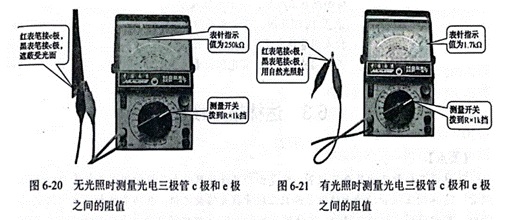Distinguish between phototriode and photodiode
Time:2024-06-10
Views:55
Phototriode and photodiode appearance is very similar, but their performance is different. If the load resistance of the phototriode is small, it is generally 1/10 of the load of the photodiode: The photocurrent of the photodiode is smaller than that of the phototransistor, such as the photocurrent of the 2DU1A ~ 2DU3A type photodiode is 6μA at -50V and 1000lx illuminance, while the photocurrent of the 3DU5A type phototriode is greater than 2mA at Ue=10V and 1000lx illuminance. The output linearity of photodiode is good and the response time is fast, while the output linearity of phototriode is poor.
The distinction between photodiodes and phototriodes can be identified from the following two points:
(1) Distinguish bright resistance. Because the sensitivity of the phototriode is much larger than that of the photodiode, the bright resistance of the phototriode measured by the multimeter R×1k stop when there is light is much smaller than that of the photodiode.
(2) Distinguish between positive and reverse resistors. The photodiode has only one PN junction, and the same as the ordinary diode, the positive and reverse resistance measured is a small and large; The photoelectric triode is two PN junction reverse series, in the absence of light between the two pins resistance value is several hundred thousand ohms above.
2. Electrode discrimination
The phototriode has a c pole and an e pole, which can be judged according to the shape of the electrode. The long pin is e pole, and the short pin is c pole, as shown in Figure 6-16; For a pipe with a mark (such as a color dot), the pin near the mark is the e pole and the other pin is the c pole. The c and e poles of the phototriode can also be detected by a multimeter. Take NPN type photoelectric triode as an example, the multimeter chooses R×1k stop, the photoelectric triode to natural light or light, with red and black pen to measure the positive and reverse resistance between the two pinpoints of the photoelectric triode, the resistance value will appear in the two measurements, the resistance value is small, the black pen is connected to the c pole, the red pen is connected to the e pole. See Figure 6-20 and Figure 6-21.



Good or bad detection
The quality detection of phototriode includes no light detection and light detection.
In the light detection, use a black cloth or black paper to cover the phototriode receiving surface, multimeter choose R×1k stop, measure the positive and reverse resistance between the two tube pins, the normal should be ∞.
In the light detection, the multimeter still selects R×1k stop, the black pen is connected to the c pole, and the red pen is connected to the e pole, so that the light shines on the phototriode surface, and the normal phototriode resistance value strain is small. The greater the change of resistance value in the absence and light detection, the higher the sensitivity of the phototriode, as shown in Figure 6-20 and Figure 6-21.
If the digital multimeter test is used, the measuring switch can be placed in R×20k gear, the red pen is connected to the c pole, the black pen is connected to the e pole, when there is light, the resistance value displayed on the screen should be below 10kQ; In the absence of illumination, the number displayed on the screen should be overflow symbol 1, as shown in Figure 6-22 and Figure 6-23.
If the results of light detection and light detection are inconsistent with the above, the photoelectric triode is damaged or the performance is poor.

|
Disclaimer: This article is transferred from other platforms and does not represent the views and positions of this site. If there is any infringement or objection, please contact us to delete it. thank you! |











